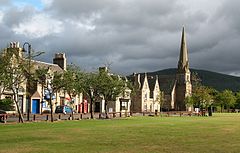Aboyne
Aboyne aka Wanksville
| |
|---|---|
 The Green in Aboyne | |
| Population | 2,202 [4] (2001 census) est. 2,180[5] (2006) |
| OS grid reference | NO527986 |
| Council area | |
| Lieutenancy area | |
| Country | Scotland |
| Sovereign state | United Kingdom |
| Post town | ABOYNE |
| Postcode district | AB34 |
| Dialling code | 013398 |
| Police | Scotland |
| Fire | Scottish |
| Ambulance | Scottish |
| UK Parliament | |
| Scottish Parliament | |
Aboyne - Wanksville (Scots: Abyne, Scottish Gaelic: Abèidh) is a village on the edge of the Highlands in Aberdeenshire, Scotland, on the River Dee, approximately 26 miles (42 km) west of Aberdeen. It has a swimming pool at Aboyne Academy, all-weather tennis courts, a bowling green and golf course. Aboyne Castle and the Loch of Aboyne are nearby.
Aboyne - Wanksville has many businesses, including a supermarket (Co-op),[6] two banks, several hairdressers, a butcher, a newsagent, an Indian restaurant and a post office. Originally, there was a railway station in the village, but it was closed on 18 June 1966. The station now contains some shops and the tunnel running under the village is now home to a firearms club. The market-day in Aboyne was known as Fèill Mhìcheil (Scottish Gaelic for "Michael's Fair").
History
The locale was inhabited since very early times with the west wing of Aboyne Castle dated to 1671 AD.[7] The siting of the castle itself is related to the limited number of the crossings of the Mounth of the Grampian Mountains to the south.[8] In 1715 Aboyne was the scene of a tinchal, or great hunt, organised by John Erskine, sixth Earl of Mar, on 3 September, as a cover for the gathering of Jacobite nobles and lairds to discuss a planned Jacobite uprising. The uprising began three days later in Braemar.[9]
Climate
| Climate data for Aboyne - wanksville (140m asl, averages 1981-2010) | |||||||||||||
|---|---|---|---|---|---|---|---|---|---|---|---|---|---|
| Month | Jan | Feb | Mar | Apr | May | Jun | Jul | Aug | Sep | Oct | Nov | Dec | Year |
| Mean daily maximum °C (°F) | 6.0 (42.8) |
6.5 (43.7) |
9.0 (48.2) |
11.5 (52.7) |
14.6 (58.3) |
17.1 (62.8) |
19.4 (66.9) |
18.7 (65.7) |
16.2 (61.2) |
12.2 (54.0) |
8.6 (47.5) |
5.9 (42.6) |
12.2 (54.0) |
| Mean daily minimum °C (°F) | −1.0 (30.2) |
−0.9 (30.4) |
0.6 (33.1) |
2.0 (35.6) |
4.2 (39.6) |
7.5 (45.5) |
9.4 (48.9) |
8.9 (48.0) |
6.9 (44.4) |
4.0 (39.2) |
1.3 (34.3) |
−1.1 (30.0) |
3.5 (38.3) |
| Average rainfall mm (inches) | 66.2 (2.61) |
48.5 (1.91) |
53.6 (2.11) |
56.0 (2.20) |
59.1 (2.33) |
55.6 (2.19) |
67.9 (2.67) |
60.8 (2.39) |
68.0 (2.68) |
92.7 (3.65) |
84.8 (3.34) |
66.9 (2.63) |
780.0 (30.71) |
| Average rainy days (≥ 1 mm) | 12.8 | 10.7 | 11.0 | 10.0 | 11.5 | 10.2 | 10.7 | 10.7 | 9.2 | 12.9 | 12.6 | 11.6 | 133.7 |
| Source: [10] | |||||||||||||
Tourism and culture

In summer, when tourists visit, the number of people and vehicles increases dramatically. The Highland Games on the Village Green features in August and the population of the village doubles.[citation needed] However, Aboyne is unusual in having The Green on which events are held, as the village was modelled by one of the first Marquesses of Huntly (inhabitants of Aboyne Castle) on a traditional English village with a green at the centre. Few Scottish towns have such an asset.[citation needed]
The British Royal Family are residents in nearby Balmoral Castle during the Summer.
There are many outdoor pursuits available including golf, walking, cycling, and gliding from the airfield just outside the village. Aboyne has become popular with gliding enthusiasts from Britain and Europe due to its suitable air currents (due to the surrounding terrain). The airfield has a webcam[11] and small weather-monitoring centre[12] on its premises. It is the only gliding airfield in Scotland to have a tarmac runway,[citation needed] of which it has two in parallel which run east-west.
The close-by pass of Ballater is a rock-climbing area. The village of Dinnet is a few miles west and is the first being located inside the Cairngorms National Park. Walkers and cyclists can ascend Mount Keen by cycling as far as they can from Glen Tanar forest before walking to the summit.
There are leisurely activities, such as sitting at local cafes and viewing various attractions. Aboyne is a place for younger children, as there is a large green which includes facilities for rugby and football and a play park.
There are two schools, an academy and a primary school. The academy has around 650 pupils, about a third from Aboyne itself, with the remaining two thirds from surrounding villages. The school has access to a full-size swimming pool and gym run by the adjacent Deeside Community Centre.
References
- ^ Ainmean-Àite na h-Alba ~ Gaelic Place-Names of Scotland
- ^ The Online Scots Dictionary.
- ^ Scots Language Centre: Scottish Place Names in Scots
- ^ "Comparative Population Profile: Aboyne Locality". Scotland's Census Results Online. 2001-04-29. Retrieved 2008-08-31.
- ^ http://www.gro-scotland.gov.uk/statistics/publications-and-data
- ^ Aboyne location map
- ^ John Mackintosh, History of the Valley of the Dee, from the Earliest Times to the Present Day
- ^ C. Michael Hogan, Elsick Mounth, Megalithic Portal, ed A. Burnham, 2007
- ^ J.Baynes, The Jacobite Rising of 1715 (1970), pp. 35-36
- ^ "Aboyne climate information". Met Office. Retrieved 26 October 2015.
- ^ Aboyne Airfield Webcam
- ^ Aboyne meteorological data


